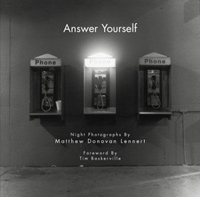Answer yourself
Review of Matthew Donovan Lennert's book of black and white Night Photography
by Andy Frazer,
November 2003
 Night photographers are an unusual breed of people. In Matthew Donovan Lennert’s new book, Answer Yourself, the author states that when he photographs at night, “There’s adrenalin present, and a feeling that you’re really not supposed to be there, but you ARE there”. The 28 black-and-white photographs in this book successfully demonstrate Lennert’s mastery of the medium of night photography, and also convey to the reader (who’s probably sitting safe at home) some of this primal emotion that he must have experienced while standing in the night air exposing each negative for as long as an hour and a half. Night photographers are an unusual breed of people. In Matthew Donovan Lennert’s new book, Answer Yourself, the author states that when he photographs at night, “There’s adrenalin present, and a feeling that you’re really not supposed to be there, but you ARE there”. The 28 black-and-white photographs in this book successfully demonstrate Lennert’s mastery of the medium of night photography, and also convey to the reader (who’s probably sitting safe at home) some of this primal emotion that he must have experienced while standing in the night air exposing each negative for as long as an hour and a half.
In “Go Cautiously Into The Gates of Hell” we see a network of roads cutting over, below and through a non-descript, industrial overpass at night. The stark utilitarianism of the cement bridge and the indistinguishable graffiti convey that this is not a safe neighborhood, and the long trails of automobile headlights make us wonder how long the photographer stood below the bridge, with his camera equipment in hand, as car after car of questionable characters drove by. In “From My Rooftop, Study 1” we see a weathered water tower lit up brilliantly at night over the cityscape of Atlanta, GA. But the vacant buildings below the tower look almost derelict against the brilliant skyline in the distance. As one looks at this photograph, the reader has to ask himself what sort of neighborhood the photographer lived in, and what sort of danger, if any, did he put himself in while shooting this photograph.
But other photographs in the book successfully communicate the sense of isolation and stillness that one encounters at night, without the foreboding sense of danger that you experience in the urban environment. In “North Star, Cliff House” and “Lone Mountain” (both shot in San Francisco, CA), Lennert has beautifully combined stunning cloud formations with the trees and cliffs of the Pacific Ocean in a manner that can only be achieved at night, when thin cirrus clouds streak across the negative forming large swathes of white rays. No other visitors see this experience: only the photographer. My favorite photograph in the book is “Transparent Tan” where Lennert has captured a handful of beach chairs late at night on a deserted Florida beach. The palm trees in the distance sway in the trade winds blurring across the long exposure, and the lounge chairs remain arranged for beach-goers as if it were high-noon. But the Florida sun has long since set below the horizon, and beach-goers are holed up inside their hotels, or drinking at the bars. The volleyball net in the background sits deserted in the darkness, and the hotel towels, which are still draped across the lounge chairs as if someone is lying on top of them, sway in the wind during the long exposure causing ghost-like images across the film. As long as it remains dark, the photographer has the beach to himself.
Although I have never met Matthew Donovan Lennert, I have spent many nights on my own standing quietly over my camera at night, waiting and waiting for the exposures to finish. There’s a wide spectrum of feelings that you can only experience while shooting at night. Sometimes you feel totally safe outside because you know nobody else is near, but at the same time you may feel equally unsure if someone (or something) is hiding the shadows. You could be standing in a quiet, desolate location in a natural setting, or you could be standing in a deserted urban location that bustles with people during the day, and you realize that you’re privileged to see this setting all by yourself. Each of Lennert’s night photographs capture these very essences, often all in a single photograph. Reading his book feels just like standing outside shooting at night, but without the bleary eyes and the cold feet.
|
